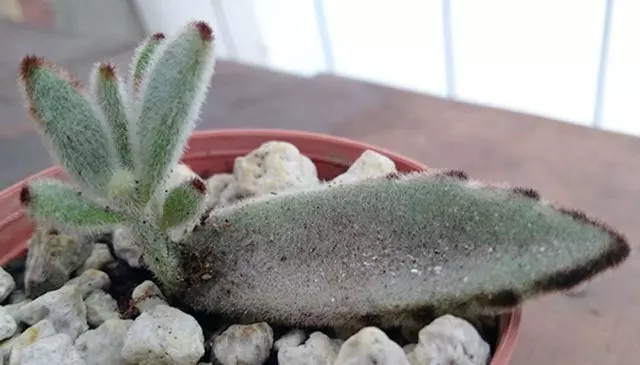Have you ever been tempted to touch a plant because of its appearance? We have, and there are many succulents whose texture and shape make us want to get to know them by touch. Learn all about Kalanchoe tomentosa care in this article.
So today we are going to learn about a beautiful succulent, not only for its color and shape but also for its texture, this little plant has the name Kalanchoe tomentosa.
And as is our custom we list some of the names by which this kalanchoe is popularly known and they are:
- Pussy ears
- Panda plant
It is a very beautiful plant and is not complicated to care for, so we recommend it for those starting out with their succulent collection.
What’s better, this Kalanchoe tomentosa is one of the few succulents we can have indoors.
So below I share with you everything we know about this pretty succulent and its care.
Table of Contents
Characteristics Of Kalanchoe tomentosa
Kalanchoe tomentosa is native to Madagascar and belongs to the Crassulaceae family.
It is a shrubby plant, its stems grow erect and when this kalanchoe matures, they begin to thicken and branch from the base.
Its leaves are oval-shaped, grayish-green, which are covered by a layer of hairs (tomentum) that give it a totally velvety or plush texture.
These leaves have dark brown or black serrated edges, which are what has given it its colloquial name of panda plant or rabbit ears.
It does not grow much, the maximum height it can reach is 3.2 ft (1 m).
If you are going to collect this kalanchoe, consider that it is a plant that grows a little slower than other succulents, so do not despair and with patience, you will see that little by little it will form a bigger and more beautiful plant.
- SIZE: Succulents come in 2", 4, 6" pots ( Depending on your desired selection from above) fully rooted in soil. Plant measurements will vary as different species grow in different ways: for example, some grow wider, shorter, taller, trailing etc.
- LICENSED GREENHOUSE GROWN PLANTS: Have confidence in ordering from a CA Licensed greenhouse succulent and cactus Nursery. Succulents bring a colorful addition to your home with the benefits of minimal watering and low maintenance to fit your busy lifestyle.
- TRACKING DELIVERY: Please keep track of the package once shipped to ensure it is received when the carriers delivers and isn’t left out longer than it needs to as this may cause damage to your plants. Plants should immediately be taken out of the box upon delivery and Lightly watered if soil is dry. Always keep your plants away from direct sun and only keep them in partial sun/shaded areas.
Care of Kalanchoe tomentosa
Follow all these tips to learn how to properly care for your Kalanchoe tomentosa.
Kalanchoe Tomentosa Care – Light:
Our Kalanchoe tomentosa are succulents that can withstand direct sun exposure well.
Remember that before leaving your panda plant in a place where it gets a lot of direct sun, it is necessary to make a previous adaptation, that is to say, to get your plant used to receive the sun little by little.
As we mentioned at the beginning, this succulent can be grown indoors, just be sure to place it in a place where it receives very good lighting and that’s it. As you will see, Kalanchoe tomentosa does not require much care.
Kalanchoe Tomentosa Care – Watering:
This type of Kalanchoe does not require very frequent watering, so if you are a beginner it will be enough if you follow the rule of watering it every time its substrate is completely dry.
When you have a little more experience with this little plant, you will realize that it keeps well even with a little more spaced watering.
In our case, we water the Kalanchoes tomentosa every 15 to 20 days at depth and they are in perfect condition.
Note: it is important that you consider that if your Kalanchoe is inside your home, take care of the frequency of watering, because being inside, the humidity of its substrate will be maintained for longer.
By the way, since the plant is covered with hairs, I recommend that you water it directly on the substrate and not on the plant, to avoid the appearance of fungus on the stem and leaves due to excess humidity.
In winter it is convenient to water it only once a month.
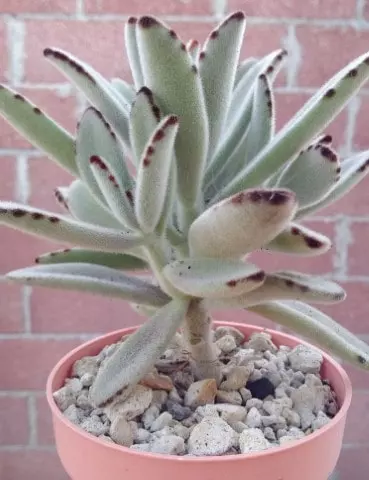
Temperature:
When it comes to temperature, just keep in mind that our Kalanchoes tomentosa do not tolerate temperatures below 50 °F (10°C). It is important to control the minimum temperature that our Kalanchoe tomentosa will receive for correct care.
So, if the temperature is very low where you live, we advise you to keep your panda seedlings in a pot that allows you to shelter them during cold periods.
It thrives best in temperatures ranging from 68 to 86 °F (20 to 30°C).
Substrate:
Fortunately Kalanchoe tomentosa is a succulent that does not require great care with the substrate.
What we have to do is to form a mixture that drains well and our panda plant will grow without problems.
We like to use a 60% inorganic and 40% organic mix and we have seen that they have developed favorably.
Being a very slow-growing succulent, it is not necessary to renew the soil of this one every year, with doing it every two years will be more than enough.
The best soil for Kalanchoe tomentosa care (Order it here).
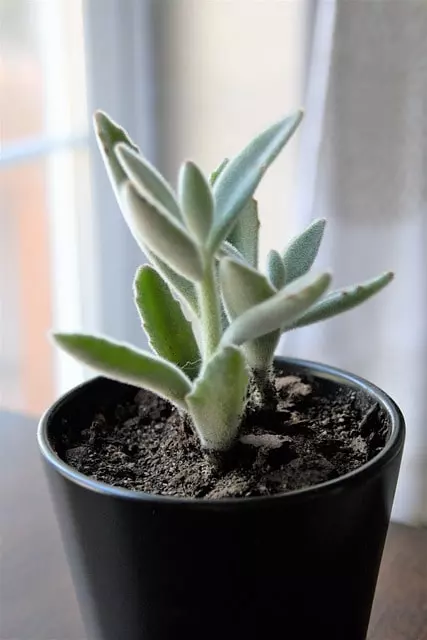
Fertilization:
It is not necessary to fertilize our Kalanchoe tomentosa, since it is a plant that grows very well with the nutrients found in the substrate.
But if you consider that you want to fertilize it we recommend that you, do it in a natural way and for this, you can use any of these options:
- Banana peel tea. It can be once or twice a month.
- Chamomile tea. Likewise, once or twice a month.
- Rice water. This is the water left over from washing the rice, it can be applied once a month.
You should also use a fertilizer like this one we use (Order it here).
How to Propagate Kalanchoe tomentosa
This topic is very important if you want to have a garden with a lot of Kalanchoe tomentosa in it.
To ensure success in the propagation of your Kalanchoe tomentosa we suggest that you do it either by stem cutting or by leaf.
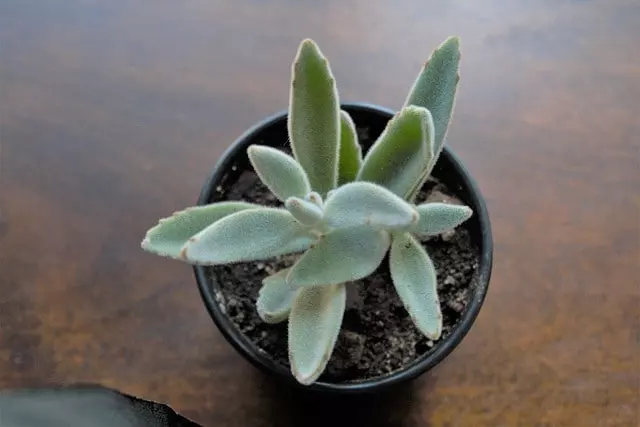
Kalanchoe tomentosa Propagation by Stem Cutting:
This type of propagation in our Kalanchoes is very simple, once your panda seedling has good size (already exceeded the 3″ pot) will be the ideal time to start cutting one or two cuttings.
So, take a razor, knife, or power scissors, previously disinfected with alcohol, and cut the chosen cutting as close to the main stem as possible.
Once you have your cutting you can add some powder in the cut, with some options that we give you in this article: Healing powders for cuts in succulents and cacti, and place the cutting (without planting) in a place where it does not get direct sunlight to heal.
We suggest leaving it like this for a week and then plant it on the substrate that we have already prepared for it.
You can start watering it three days after planting the cutting, it is not necessary that this watering is deep, just make sure to moisten the substrate a little to encourage the roots to come out.
Kalanchoe Tomentosa Propagated by Leaf:
This propagation is also very simple, just very slow.
Separate healthy and large leaves from your Kalanchoe tomentosa, remember that the leaf must be completely detached to ensure the success of the reproduction.
Place it on a small layer of substrate in a place with very good lighting and forget about it, it will take more than a month to come out, depending on the conditions of your climate.
Once the first roots of your leaf start to grow you can place it in a small pot and start spraying it lightly.
Little by little you will be able to observe how the new plant develops.
Kalanchoe tomentosa Flower
It is unlikely that our Kalanchoe tomentosa will ever flower, if they do it will be in mid-spring, and once our succulent is a fully grown plant.
Its flowers are very small, bell-shaped, and not very showy, but considering that it flowers very little, if your plant does feel lucky and enjoy them.
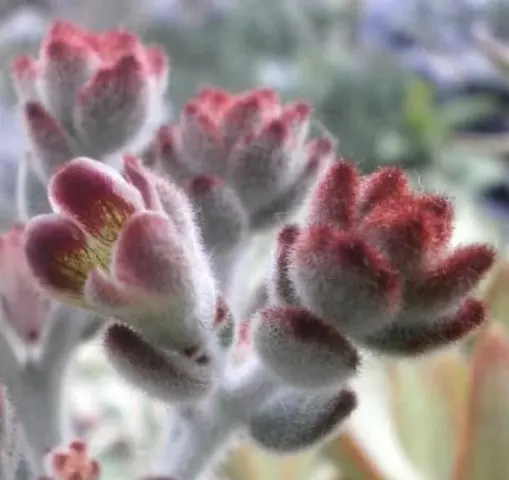
Frequent Problems in Kalanchoe tomentosa:
The pest that can attack our kalanchoes is the cottony mealybug, so whenever you have the opportunity check it under its leaves and stems to detect it in time and fight it.
It can also suffer from fungus attacks due to excess humidity in its leaves, to avoid this, try to water only on the substrate.
We hope this article has pleased you and will be useful to take good care of your Kalanchoe tomentosa. Learn more about Kalanchoe luciae.
